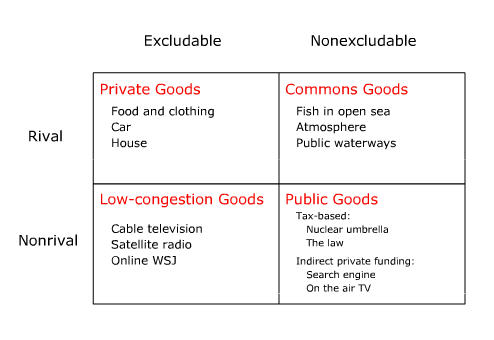Some goods, like apples, are subject to consumption rivalry. If I eat the apple, it is no longer available to anybody else. But other goods are not subject to consumption rivalry. Many people can tune in to the same radio signals at once without degrading them.
Similarly, it is easy to exclude non-paying customers for apples. But it is impossible to exclude free riders on public radio signals.
We can classify goods by drawing a two-by-two matrix based on high or low rivalry on the one hand and high or low excludability on the other as follows:

Rivalry and excludability are related. If there is no rivalry in consumption, there is no reason to exclude except to raise funds. But funding availability does not eliminate rivalry. One apple cannot be shared with an unlimited number of people. So goods subject to consumption rivalry will never become public goods.
On the other hand, how non-rival goods are funded can determine whether a good becomes a public good or simply a low-congestion good. For example, a search engine with practically unlimited capacity for search traffic would become a public good if it is indirectly supported through advertising revenues. But the same search engine would become a low-congestion good if it is fee-based. It is technically feasible to exclude users in either case, but there is no point to exclude if excluding some users might reduce the amount of ad-supported revenues.
Both indirect funding of public goods and direct fees for low-congestion goods are means to avoid free-ridership where some users enjoy the service without paying. When a good is not subject to consumption rivalry, indirect funding would generate maximum benefit because even users with low marginal benefit will be attracted to the zero marginal cost. But the content of the goods might be affected by how the service is funded. For example, over the air network TV and Public Television are both public goods, but there is a tendency for TV networks to appeal to the lowest common denominator in order to maximize ad revenues.
Conversely, if there is rivalry in consumption, there is every reason to exclude. Both private goods and commons goods are subject to consumption rivalry. But it is much more difficult to clearly define and enforce the property rights for commons goods. Hence the tragedy of the commons.
High enforcement cost can transform private goods into de facto commons goods and low-congestion goods into de facto public goods. For example, the unfenced front lawn of your house (private good) has become the public toilet (commons goods) of your neighbors' dogs. And private-label digital music (low-congestion good) has become a freebie (public good) for the file-sharing community.